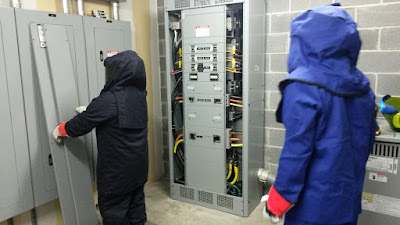The rules surrounding electrical
safety continue to change. There are
three main components that are affecting change: scientific data, safety
professionals, technology. Researchers
continue to develop and communicate new understanding of shock, arc flash, and
other electrical hazards. Safety
professionals are working hard to set a safe working culture within the workplace. Technology is being created to mitigate
electrical hazards.
 There are multiple methods to
reduce hazards. Risk reduction
techniques are commonly divided into engineering and administrative
controls. Reducing hazards through
engineering methods (elimination, substitution, guarding, and safety controls)
is preferred over administrative methods (operating procedures, training, and
personal protective equipment).
There are multiple methods to
reduce hazards. Risk reduction
techniques are commonly divided into engineering and administrative
controls. Reducing hazards through
engineering methods (elimination, substitution, guarding, and safety controls)
is preferred over administrative methods (operating procedures, training, and
personal protective equipment).
However, most of the efforts to reduce employees
to electrical hazards have been focused on administrative methods. The use of administrative methods (operating procedures, training, PPE, signage) is not the same as eliminating the hazard, guarding the hazard, or using safety controls to eliminate access to the hazard.
Companies are implementing safe work practices, electrical safety training programs and procuring shock and arc flash personal protective equipment (PPE). The Standard for Electrical Safety in the Workplace, NFPA 70E, provides guidance for standard operating procedure, training, and personal protective equipment (PPE) for qualified people working on or near exposed live (energized) circuits.
Companies are implementing safe work practices, electrical safety training programs and procuring shock and arc flash personal protective equipment (PPE). The Standard for Electrical Safety in the Workplace, NFPA 70E, provides guidance for standard operating procedure, training, and personal protective equipment (PPE) for qualified people working on or near exposed live (energized) circuits.
Safe work practices associated
with electrical safety include the control of hazardous energy (Lockout Tagout)
procedures, procedures for working on exposed live (energized) circuits, and
electrical hot work permits. OSHA
requires that each company is responsible for developing, implementing,
auditing the safe work practices to ensure that their employees have safe work
conditions.
Companies are ensuring that
employees who are working on or near exposed live (energized) circuits complete
electrical safety training programs. The
consensus is that comprehensive electrical safety training is to be conducted
at least every 3 years, and annual competency of refresher training be
conducted every year between the comprehensive electrical safety training. Electrical safety training is required for
everyone who works on or near exposed live (energized) circuits where the
voltage is 50 V or greater, or if the energy available can expose employees to
shock or arcing hazards. The elements of
an electrical safety training include definition of hazards, safe work
practices, use of PPE, use of tools, and understanding arc flash labels. Testing is required to ensure that employees
understand the concepts taught. Testing
should include a written test and practical examination.
 PPE is used to protect employees
from shock and arcing hazards. Shock
hazard PPE include voltage rated gloves, blankets, and mats. Arcing hazard PPE include hard hat, leather
gloves, leather shoes, arc rated clothing, arc rated face shield or arc rated
hood, and safety glasses. The rating of
the PPE is determined through the calculation of the voltage (shock) and
incident energy (arcing) energies. Shock
hazard PPE is identified by Class.
Arcing hazard PPE is identified by Category or Incident Energy
Rating. Employees working on or near
exposed live (energized) circuits are required to wear BOTH shock and arcing
hazard PPE.
PPE is used to protect employees
from shock and arcing hazards. Shock
hazard PPE include voltage rated gloves, blankets, and mats. Arcing hazard PPE include hard hat, leather
gloves, leather shoes, arc rated clothing, arc rated face shield or arc rated
hood, and safety glasses. The rating of
the PPE is determined through the calculation of the voltage (shock) and
incident energy (arcing) energies. Shock
hazard PPE is identified by Class.
Arcing hazard PPE is identified by Category or Incident Energy
Rating. Employees working on or near
exposed live (energized) circuits are required to wear BOTH shock and arcing
hazard PPE.
Companies have used administrative methods as these are well known and can be easily identified in the company budget. When implementing any component
of the administrative methods to reduce shock and arcing hazards, it is
important to have experienced and knowledgeable professionals involved. The writers of the safe work practices can
only produce effective procedures is done by competent technical writers with knowledge of the process and how to write effectively. Training employees can only be effective when the
trainer is a trained professional experienced in the craft of teaching and electrical safety. The
PPE used must be certified, regularly tested, and verified it is serviceable prior
to each use.
The use of operating procedures, training, and PPE can reduce accidents associated with electrical hazards. However, administrative methods are not as effective at reducing accidents as engineering mitigation techniques.
The use of operating procedures, training, and PPE can reduce accidents associated with electrical hazards. However, administrative methods are not as effective at reducing accidents as engineering mitigation techniques.
